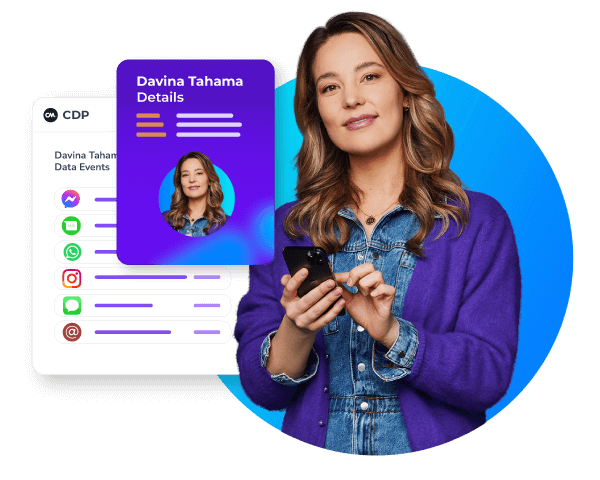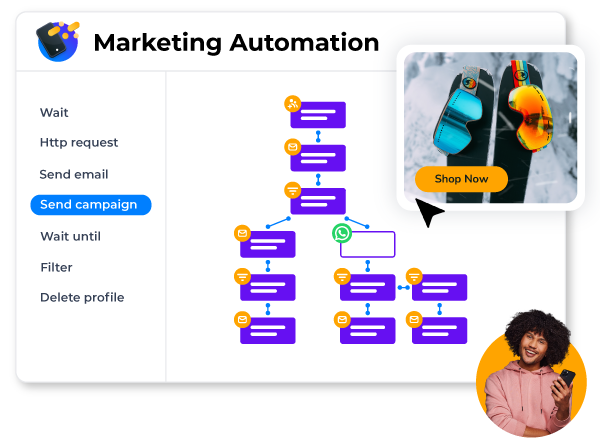What Is a CDP or Customer Data Platform?
A CDP or Customer Data Platform is a software that collects customer touchpoints and interactions with your product or service from various channels and sources. It aggregates all this data from multiple sources to create a unified profile of each customer.
A CDP gathers and organizes data in real-time to create profiles for each customer through its centralized database.
How Does a CDP Work?
A CDP integrates data from various sources to form a unified database. This covers everything from internal customer relationship management (CRM), data management platform (DMP), and transactional systems to website and e-commerce behavioral data.
Discover the differences between CRM, CDP, and DMP platforms >
A CDP typically aggregates data from a combination of first-, second-, and third-party sources. First-party data is data collected about your own customers from your website, app, social media, surveys, and other offline sources. First-party data typically includes information such as:
Demographics
Website visits and interactions
Purchase history
First-party data is one of the most valuable kinds of data, and most importantly, it can be collected for free. As long as you have your customers’ consent, your company owns the data and can use it to create personalized experiences or target customers with relevant ads.
Third-party data is first-party data collected by another source’s customers and purchased. In comparison, third-party data is purchased from companies that don’t have a direct relationship with customers, like data providers that aggregate customer information to sell on global data platforms.

Although first-party data gives you the most accurate view of your customers, third-party data can help fill in the blanks in your CRM system.
By combining first- and third-party data in a customer data platform, your organization gains complete visibility of your customer base so you can more accurately target a specific audience.
What Is a CDP Used For?
Here are some key features of customer data platforms.
Collects Data
A customer data platform organizes several main categories of customer data, including:
Identity data, which uniquely identifies each customer by name, location, contact information, demographics, social media, account number, and more
Descriptive data, which creates a fuller picture of the customer using information about their career, income level, lifestyle, hobbies, or family
Quantitative data, which shows how the customer has interacted with your business, e.g., transactional and order data, online activity
Qualitative data, which provides additional context about the customer, like their motivation and opinion about your business
Social data, which is information that social media users publicly share, e.g., metadata, shared links, language
Mobile data, which analyzes customer behavior through mobile channels
How Much Data Are You Missing?
Creates Customer Profiles
Without a customer data platform, you might not be able to track all the ways your customers interact with your business. Although this might not seem like a big deal, you could send irrelevant marketing messages to the wrong audience or lose customers before they complete their purchase.
The primary feature of a customer data platform is its ability to create profiles for your customers based on collected data. A CDP collects, standardizes, and connects this information to create a complete view of each individual customer and their relationship with your business.
Then, you can leverage that data to create marketing campaigns, provide personalized customer service, and even support the in-person shopping experience.
Creates Customer Segments
Once you have a complete view of your entire customer base, you can use your CDP to make informed, data-driven decisions in your marketing efforts. One of the best ways to put your customer data to work is to use audience segmentation: grouping customers based on common characteristics to create targeted marketing campaigns.

Audience segmentation helps your organization match your products and services to customers based on their specific needs and preferences. For example, you can segment your customer base to target people who visited specific pages on your website. You could also use audience segmentation to see how many people abandoned their carts and when during the customer journey.
Smart customer segmentation is an invaluable part of the marketing process. It helps your business identify browsing and buying trends among your customers, enabling you to send targeted messages that grow your customer base and improve customer retention.
Supports Compliance Requirements
Businesses that handle customer data must comply with data privacy regulations like the General Data Privacy Regulation (GDPR) in the European Union. These regulations require that your company gets consent from your customers before you start collecting it.
For example, regulatory requirements like the Telephone Consumer Protection Act (TCPA) require opt-in text messaging. The TCPA mandates that businesses must get express written consent from their customers before sending marketing messages via SMS.
Eliminates Data Silos
A data silo is a collection of data that is isolated from the rest of an organization, leading to a lack of transparency and efficiency. Businesses typically accrue data silos when they scale quickly without planning how to share access to data across the organization.
By aggregating your customer data into a single platform that all team members can access, you can ensure that your data is accurate and accessible. As a result, your marketing team can create targeted marketing campaigns, and finance and operations teams can better understand payment patterns, buying behavior, and more.
What Are the Benefits of Using a CDP?
Customer data platforms can improve your overall business by providing insights into your customer relationships with existing software and marketing campaigns. Below are some of the main benefits of adding a CDP to your marketing toolbox.
Enhanced Collaboration
You likely have many sources of customer data throughout your organization. Using a CDP to aggregate this information creates a centralized database that anyone on your team can use.
In addition to making your customer data more accessible, a CDP also ensures that there is a single, accurate source of information updated regularly. This way, your team uses the latest information without worrying about it being redundant or irrelevant.
Organized Customer Data Management
A customer data platform helps connect all of a customer’s touchpoints, from opening a marketing email and browsing your website to comparing similar products from competitors. By gathering all this information in a customer profile, you can gain valuable insights into the customer journey that can help you drive both conversion and customer loyalty.
Insightful Customer Analytics
A successful marketing campaign can predict its target audience’s needs better than customers. By leveraging the power of your customer data, a CDP can provide valuable insights into customer preferences, behavior, and shopping habits so you can get to know every one of your customers.
With this information, you can easily create a seamless experience for all your customers according to their unique profiles.
Improved Systems Integration
Scaling your business is always exciting, but it often leads to more software, more groups of data, and more confusion. A customer data platform integrates multiple tools or channels to create a centralized source for all your data.
Unified Cross-Channel Marketing
Today, nearly every business has invested in cross-channel marketing, which distributes campaigns through multiple channels like social media, email, mobile apps, websites, and more. Although balancing numerous marketing efforts at once is more common, collecting, understanding, and sharing the data you need for these projects can be time-consuming.

But with a CDP, you have access to consolidate accurate data that you can update in real-time. Not only does this support collaboration across multiple campaigns, but your CDP can continue to organize incoming data for future marketing efforts.
Looking for a CDP? Try CM.com’s Mobile Marketing Cloud
Even if you have access to tons of customer data, you might not know how to collect, analyze, and utilize that data. That’s where a customer data platform like CM.com’s Mobile Marketing Cloud comes in.
Our built-in Customer Data Platform connects multiple data sources into one unified customer profile, giving you real-time insights into your customer’s behavior. By building 360º customer profiles, our CDP can help you segment your audience and automate your campaigns with workflows.